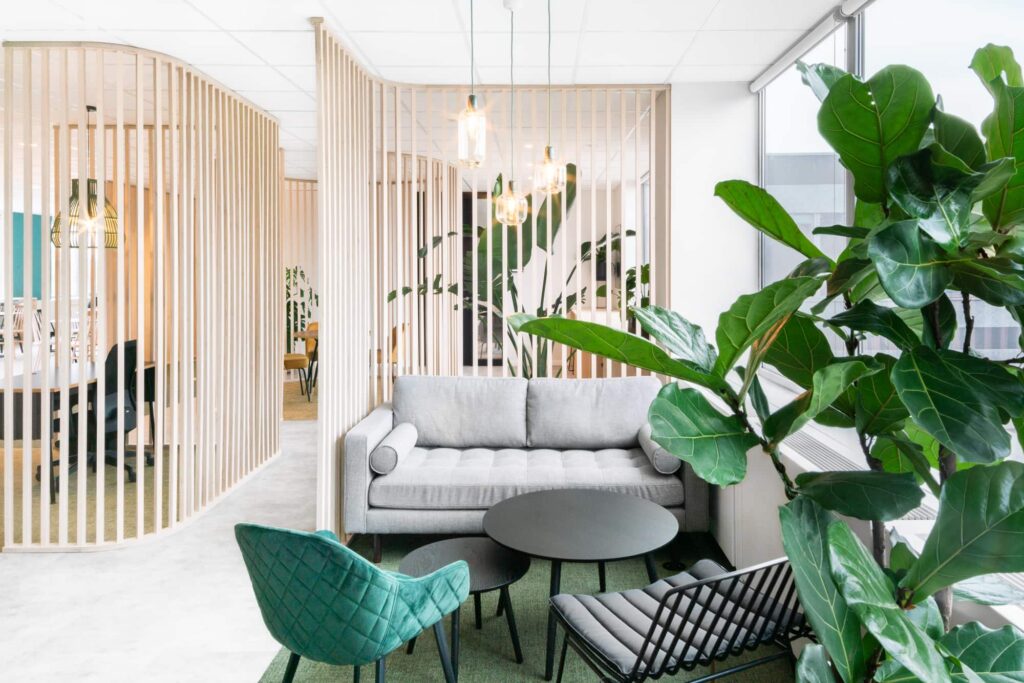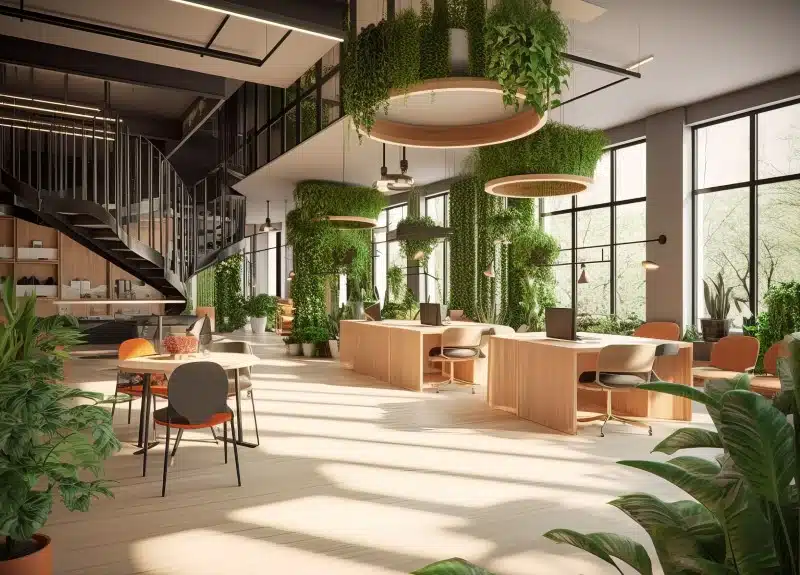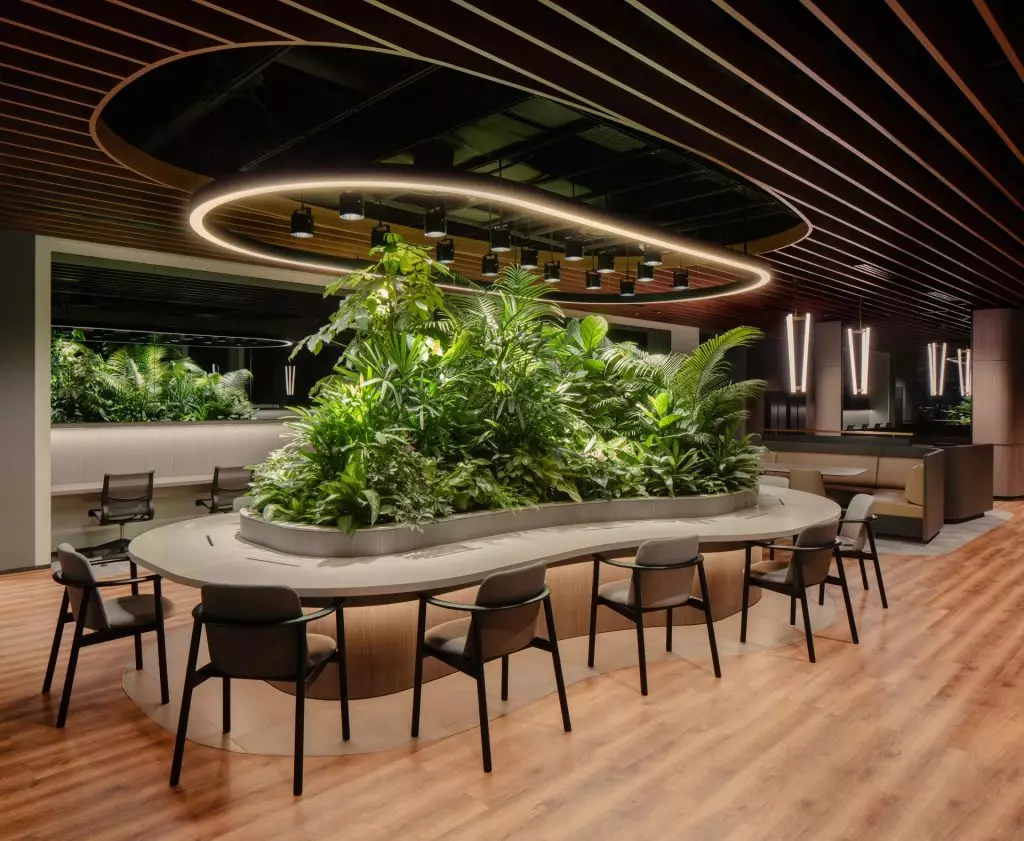In our ever-evolving urban landscapes, the yearning for a connection to nature becomes increasingly vital. The concept of biophilic design is a manifestation of this desire, a deliberate effort to weave the essence of the outdoors into the very fabric of our living spaces. This isn’t just about aesthetic appeal; it’s a transformative approach that touches on the core of human well-being. Endocrine surgeons from Texas state that a person needs contact with nature because plants soothe and relieve stress.
The Essence of Biophilic Design

At its heart, biophilic design is an acknowledgment of the symbiotic relationship between humans and nature. It recognizes that we are not separate entities but integral parts of a larger ecosystem. By incorporating natural elements into our homes, we don’t merely invite aesthetics; we invite a profound shift in our perspective. The essence lies in the deliberate blurring of boundaries, a conscious effort to erase the line between indoor and outdoor.
Consider the use of materials such as reclaimed wood, not just for their visual warmth but for the stories they carry. Each imperfection tells a tale, grounding us in the authenticity of the natural world. It’s about choosing a color palette inspired by the changing seasons, creating a dynamic environment that mirrors the ever-shifting beauty of the outdoors. Wood is a material that goes perfectly with some warm kitchen design and you can consider a custom kitchen remodeling to achieve that effect and enjoy it every time you cook. Biophilic design is a narrative woven with the threads of nature, a story that unfolds as you move through your living space.
The Impact on Well-being
The impact of biophilic design on our well-being transcends the superficial. It’s not merely about having a few potted plants or a well-placed window; it’s a holistic approach that addresses our physical and mental states. Picture a room bathed in natural light during the morning hours, the gentle warmth of the sun awakening your senses. Consider window renovation to ensure this precious moment every morning. This isn’t just illumination; it’s an energizing embrace, a natural stimulant for both body and mind.
Indoor plants, strategically placed, become more than decor; they are living, breathing companions that contribute to improved air quality. This isn’t just a nod to aesthetics; it’s a testament to the intertwined relationship between humans and the plant kingdom. The impact of natural materials goes beyond their visual appeal. Some plants, in addition to looking beautiful, can also be used to make natural collagen skincare products. Wood and stone don’t merely adorn; they resonate with our primal connection to the earth, grounding us in an elemental embrace that goes beyond the surface.
Practical Applications in Home Design
Bringing biophilic design into your home need not be an overwhelming task. Contractors from Colorado Springs agree that renovations aren’t always difficult, but that you need to turn to a professional to achieve the desired effect. It’s about thoughtful choices and a curated approach to every element of your living space. Imagine the subtle rustle of leaves as a gentle breeze wafts through your open windows. It’s not just about ventilation; it’s about inviting the symphony of nature into your home. Consider the strategic placement of greenery, not as mere adornments but as intentional elements that breathe life into your surroundings.
Natural light, a fundamental aspect of biophilic design, isn’t just about brightening a room. It’s about creating dynamic spaces that evolve with the passage of the day. Morning light invigorates, midday light energizes, and evening light soothes. It’s a choreography of illumination that mimics the natural rhythm of the outdoors. Choosing sustainable furniture isn’t just a nod to environmental consciousness; it’s a commitment to a harmonious coexistence with the planet.
A Holistic Approach to Interior Spaces
The application of biophilic design extends far beyond the confines of residential architecture. Imagine a workplace where the boundaries between the office and nature blur seamlessly. This isn’t just about increasing productivity; it’s about creating environments that inspire, innovate, and nurture the well-being of employees. A children’s dentist in Fayetteville NC says that plants in the office calm children and bring a pleasant atmosphere to an otherwise tense environment. Picture a shopping mall transformed into a haven, where the act of shopping becomes a stroll through a metaphorical forest, a sensory experience that transcends the transactional.
In commercial and public spaces, the principles of biophilic design redefine the way we interact with our surroundings. It’s not just about aesthetics; it’s about creating immersive environments that elevate the human experience. The deliberate incorporation of nature into these spaces isn’t a luxury; it’s a necessity in a world where urban sprawl threatens to sever our ties to the natural world.
Expanding the Horizon: A Deeper Dive into Biophilic Design
As we delve deeper into the realm of biophilic design, it’s crucial to recognize the nuanced aspects that contribute to its transformative power. It’s not just about placing a few plants here and there; it’s about understanding the intricate dance between form and function. The integration of water features, for instance, goes beyond visual aesthetics. It introduces the soothing sound of flowing water, a sensory experience that transcends the visual realm.
Consider the role of biomimicry, where architectural elements emulate the patterns and shapes found in nature. This isn’t just a stylistic choice; it’s a homage to the efficiency and beauty perfected by millions of years of evolution. The concept of prospect and refuge, a fundamental principle in biophilic design, goes beyond creating visually appealing spaces. It taps into our primal instincts, providing areas of openness and security that resonate with our deep-seated need for safety and exploration.
Incorporating Biophilic Design in Urban Planning

The shift towards urban living doesn’t mean sacrificing our connection to nature. In fact, it’s an opportunity to reimagine urban landscapes as extensions of the natural world. The incorporation of green roofs, vertical gardens, and communal spaces that mimic natural habitats transforms concrete jungles into vibrant ecosystems. Roofing services in Hillsborough suggest installing solar panels on green roofs to bring the beautiful and useful together in the right way. It’s not just about creating aesthetically pleasing cities; it’s about fostering communities that thrive, where the pulse of nature beats in harmony with the urban rhythm.
As we explore the potential of biophilic design in urban planning, the focus expands beyond individual homes or buildings. It becomes a collective effort to redefine the very infrastructure that sustains our modern lives. Picture a city where parks aren’t just recreational spaces but integral components of the urban fabric. Imagine streets lined with trees, not just for shade but as living sculptures that evolve with the seasons. By working together on such plans, those cities will not be just models made by CNC machining, but the reality in which we will live.
Biophilic Design and the Future of Architecture
The principles of biophilic design are not static; they are evolving with our understanding of the dynamic relationship between humans and nature. As we look to the future of architecture, biophilic design becomes a guiding philosophy, a compass pointing towards sustainable, human-centric spaces. It’s not just a trend; it’s a paradigm shift that challenges architects to think beyond aesthetics and functionality.
If you are researching Biophilic designs to incorporate in your home because you want to take your mind off the upcoming school exams for which you did not study or do not understand the material; you should never neglect your life obligations and should hire the best online test prep in Bettendorf to help you master the learning material and pass the exams with the highest scores with ease.
The integration of smart technology into biophilic design opens new possibilities. Imagine homes that respond to the changing weather, adjusting lighting and temperature to mimic the outdoor environment. Consider buildings that breathe, with facades that adapt to optimize natural ventilation. The future of biophilic design lies not just in replicating nature but in creating dynamic, responsive spaces that enhance our connection to the ever-changing world around us.
Embrace the Transformation: Biophilic Design in Your Life
As we conclude this exploration of biophilic design, the invitation is clear—embrace the transformation. This isn’t a passive appreciation of nature; it’s an active participation in a design philosophy that elevates our living spaces. From the choice of materials to the placement of furniture, let every decision be a conscious step towards creating environments that resonate with the rhythm of the natural world. If you don’t know where to start or have no ideas, visit a succulent super show or take a walk in the forest and you will get additional motivation to make a change.
Biophilic design is a journey, an ongoing dialogue between human creativity and the perfection of nature. It’s about recognizing that our well-being is intricately tied to the health of the planet. As you navigate the spaces you inhabit, let the principles of biophilic design guide you. Open your windows to the morning sun, surround yourself with greenery, and let the elements of nature become the silent companions in your daily life. Embrace biophilic design, not just as a design choice but as a transformative journey towards a more harmonious and connected way of living.
The Integration of Technology in Biophilic Design
In the ever-evolving landscape of design, technology is becoming a powerful ally in the realization of biophilic principles. Smart home systems can be seamlessly integrated to mimic natural lighting patterns, adjusting the intensity and color temperature throughout the day. Imagine waking up to a gentle simulation of dawn, gradually transitioning to a soft, golden glow in the evening – a technological embrace of circadian rhythms within the confines of your home. Keep in mind that no matter how good your Biophilic design is, it won’t fully relieve your symptoms, or heal an illness; if this does happen you should always check in the best health clinic in Marietta GA for treatment.
Moreover, virtual reality (VR) and augmented reality (AR) technologies are opening up new frontiers in biophilic experiences. Imagine a living room transformed into a lush forest or a bedroom overlooking a tranquil seaside retreat. These immersive technologies not only serve as a visual delight but also contribute to the psychological well-being of occupants by providing moments of escape and rejuvenation.
Biophilic Design Beyond Aesthetics: A Therapeutic Approach
While the aesthetic appeal of biophilic design is undeniable, its therapeutic potential is equally noteworthy. The deliberate incorporation of elements like running water, whether in the form of indoor fountains or cascading wall features, introduces an auditory component that contributes to relaxation and stress reduction. The sound of flowing water creates a soothing ambiance, fostering an environment conducive to mindfulness and mental clarity.
Additionally, the strategic placement of natural scents can further enhance the sensory experience. Essential oils diffused in living spaces can evoke the fragrance of a pine forest or a field of lavender, adding a multi-sensory layer to the biophilic design. Place a few cosmetic jars with scented candles or sticks and that will be enough to make you feel like you’re walking in the forest. These olfactory elements not only create a pleasant atmosphere but also tap into the powerful connection between scent and memory, enriching the overall experience of the space.
Biophilic Design in Urban Planning: Creating Green Oases
As urbanization continues to reshape the global landscape, integrating biophilic principles into urban planning becomes imperative. Imagine city streets lined with greenery, rooftops transformed into flourishing gardens and public spaces designed as havens of tranquility. The implementation of biophilic design on a city-wide scale can mitigate the stressors of urban life, offering residents and visitors alike a respite from the concrete jungle.
Urban planners are increasingly recognizing the importance of green spaces in fostering community well-being. Whether you put on a ponytail hat and run in the park or take a walk with someone, contact with nature is inevitable. Parks designed with biophilic principles in mind become not only recreational areas but also serve as communal hubs for relaxation and social interaction. The integration of natural elements in urban planning contributes to a more sustainable and resilient urban ecosystem, addressing the environmental challenges associated with rapid urban growth.
The Evolution of Biophilic Design: A Sustainable Future

As we look toward the future, the evolution of biophilic design extends beyond aesthetics and immediate well-being. It becomes a catalyst for sustainable living, influencing the choices we make in the materials we use, the energy we consume, and the overall ecological footprint of our living spaces. Imagine homes equipped with green energy systems, sustainable water management, and materials sourced with environmental consciousness.
Biophilic design, when coupled with sustainable practices, becomes a blueprint for a harmonious coexistence with nature. The integration of renewable energy sources, such as solar panels or wind turbines, not only aligns with the principles of biophilia but also contributes to the broader global efforts towards a greener, more sustainable future. This evolution transforms biophilic design from a stylistic preference to a responsible and ethical approach to the way we build and inhabit our spaces. In addition to all that, dumpster rental in Greeley advises how to connect with nature, we don’t just have to bring it into our environment, it’s enough if we make an effort to save it from waste and garbage.
Conclusion
In conclusion, the journey into biophilic design is a dynamic exploration that transcends the boundaries of aesthetics. It evolves with technology, embraces therapeutic elements, extends into urban planning, and ultimately shapes a sustainable future. The integration of technology brings forth a new era of sensory experiences, while therapeutic applications enhance the mental and emotional dimensions of biophilic living. Some scientists who work on RC car bodies try to find a way to integrate plants with a car body, it is an intriguing concept that falls under the broader category of biodesign or bio-integrated design. While this idea might seem futuristic, there are ongoing explorations into combining living organisms with various objects, including vehicles. As these principles find their way into urban planning, our cities become green oases, and the evolution toward sustainability becomes an intrinsic part of biophilic design. Embrace this evolution, and witness your living spaces not only as reflections of nature but as catalysts for a holistic and harmonious way of life.
